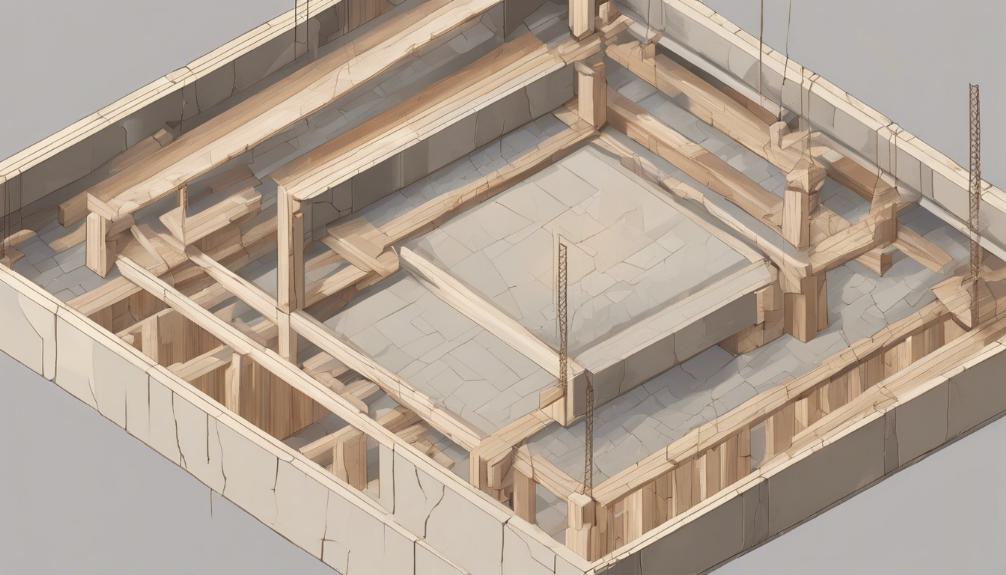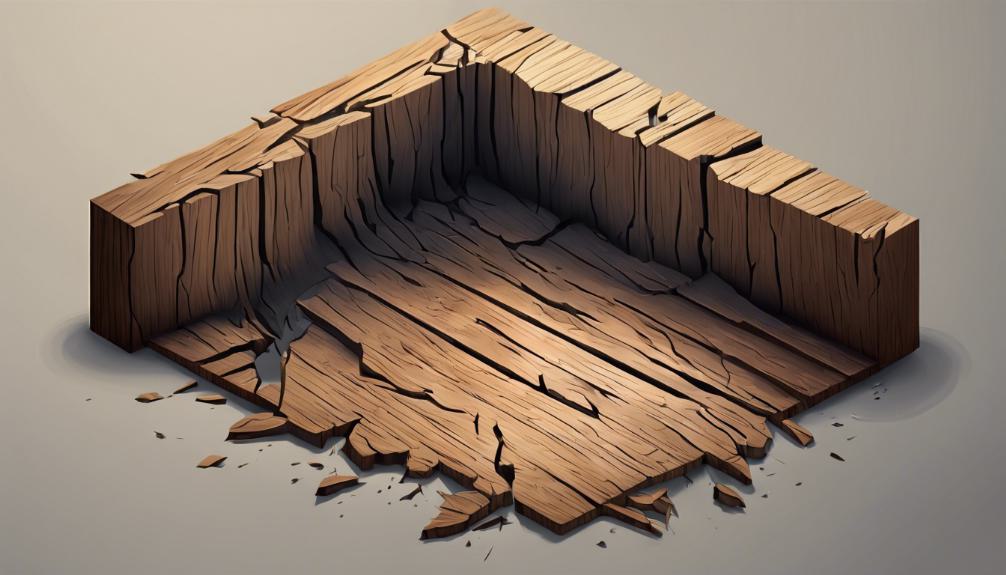If your floor is caving in, it’s serious. Look for tilting floors or cracks.
Stuck doors and water puddles are bad signs. Call a professional quickly.
- Act fast to prevent worse damage.
- Check for sloping floors and cracks.
- Contact experts for help.
Early action is crucial for safety.
What Causes Sagging Floors
If you notice your floors sagging, it’s essential to understand the potential causes. Signs like uneven floors or cracks may indicate underlying structural issues.
Take the necessary steps to inspect and address sagging floors promptly to prevent further damage.
Signs of Sinking Floors
Identify sinking floors by observing:
- House tilting to one side.
- Doors or windows sticking or jamming.
- Cracks in foundation, basement, and walls.
Act quickly to address sinking floors. Delay can lead to more damage.
Consult a structural engineer for old house foundation repair. Taking early action helps maintain your home’s structural integrity and safety.
Spotting a Sinking Floor
- Look for slanted floors to identify a sinking issue.
- Jammed doors or windows often indicate foundation problems.
- Foundation cracks are a clear sign of structural issues.
- Water puddles inside might suggest a sinking or sagging floor.
- Notice unusual changes like sagging, which point to weak structures.
- Rotted posts, foundation settling, or heavy furniture can cause sagging.
- Weakened joists and high humidity may lead to floor rot.
- Seek professional help from structural engineers if you spot these signs.
- Address issues quickly to avoid further damage and ensure safety.
- Structural experts assess, recommend repairs, and provide solutions.
Inspecting Your Home for Sloping Floors
House Construction: The way your house was built can lead to floors sagging over time.
Carpenter Ants: These pests weaken wood, causing floor sagging.
Regular Inspections: Check your home often for sagging floors to fix issues early and avoid more damage.
Potential Risks of Sagging Floors
- Inspect your home for sloping floors to identify structural issues.
- Sagging floors in older homes can be due to major support beams lacking proper support.
- Wood posts can rot and sink into the floor, causing settlement and structural problems.
- Improperly cut floor joists, insect damage, and moisture in basements can lead to sagging floors.
- Upgrade support posts to concrete pads with footings to prevent further sagging.
- Avoid cutting improper holes and notches in joists to maintain structural integrity.
- Address sagging floors promptly to avoid severe structural damage.
Sinking Floor Repair

If you’re dealing with a sinking floor, it’s important to address the issue promptly to prevent further damage.
High-pressure grouting and load-bearing piers are common solutions for stabilizing sinking floors.
Understanding the causes and repair options can help you make informed decisions to guarantee the safety and integrity of your building.
Concrete Floor Sinking: Causes and Solutions
- Unstable soil causes concrete floors to sink. This happens when soil can’t support the floor’s weight.
- Poor support from weakened beams or columns leads to sinking floors.
- Foundation settlement also results in sinking concrete floors.
Solutions include:
- Use high-pressure grouting to stabilize soil.
- Install load-bearing piers for stronger support.
- Apply helical piers to distribute weight evenly.
- Opt for Atlas resistance piers to prevent further sinking.
Act quickly with professional help to fix sinking floors and protect the building’s structure.
Sinking Floorboards Upstairs
- Address sinking floorboards promptly to prevent further damage.
- Common causes include rotted joists, settling foundations, or excess loads.
- Seek professional help for a thorough assessment.
- Solutions may involve reinforcing joists or stabilizing with piers.
- Act early to maintain safety and integrity of your home.
- Monitor for signs of sinking floorboards and take immediate action.
Sinking Floor Repair Costs
If you’re facing sinking floor issues, you might be wondering about repair costs and solutions. Understanding the factors influencing repair expenses can help you plan and budget effectively.
Let’s explore some budget-friendly fixes and clever solutions for addressing sagging floors.
Budget-Friendly Solutions for Sagging Floors
Cost-Effective Solutions for Sagging Floors
- Reinforce framing with metal or sister joists using identical lumber.
- Use flitch plates for stronger reinforcement.
- Repair compromised joists if cut, drilled, or notched.
- Upgrade support posts with concrete pads and footings.
Clever Fixes for Sagging Floors
To fix sagging floors, reinforce framing with metal or sistering lumber. Repair costs vary with damage and method.
Use flitch plates to strengthen joists. Shore up cut or notched beams for safety and integrity.
read to learn effective floor joist repair
Ensuring Structural Stability

When dealing with a floor caving in, ensuring structural stability is paramount to prevent further risks.
You must consider the possibility of sagging floors leading to potential collapses.
Taking preventative measures promptly can safeguard the occupants and the building’s integrity.
Can Sagging Floors Collapse?
- Sagging floors can lead to a collapse if not fixed.
- Weak support beams, due to rot or poor construction, reduce a building’s stability.
- Foundation settling shifts the building, making floors sag and increasing collapse risk.
- Act immediately when you notice sagging floors. Get a professional check to prevent collapse.
Preventative Measures for Future Floor Stability
- Inspect and maintain flooring regularly to avoid future issues.
- Fix water leaks quickly to ensure structural stability.
- Upgrade to durable flooring materials for longer floor life.
- Ensure proper ventilation to prevent moisture buildup.
- Seek professional advice for mobile home floor maintenance.
- Stay proactive and address warning signs immediately.
- Maintain a safe environment by preventing floor caving risks.
Frequently Asked Questions
Why Is My Floor Caving In?
If your floor is caving in, it could be due to water damage, rotted joists, or structural issues. Look for signs like cracks, sinking floors, or sagging. Immediate action is essential. Consult professionals for assessment and repairs.
How Do You Fix a Sunken Floor?
To fix a sunken floor, first assess the damage to find the cause. Repair rotted posts, reinforce joists, and stabilize the foundation. Consult with engineers for a repair plan. Use methods like grouting or piers for stabilization and prevent future sinking.
How Do You Fix a Dip in the Floor?
To fix a dip in the floor, first identify the cause like rotting joists or settling foundation. Repair by adding support beams or sistering new joists. Reinforce with plywood or replace damaged sections. Address underlying issues and seek professional help if needed for a safe solution.
How Do I Know if My Floor Is Caving In?
To know if your floor is caving in, look for cracks, sinking areas, or bowing. Listen for odd noises like creaking. Watch for sudden changes in floor levelness. Get help if you’re worried, and act fast to prevent danger.
